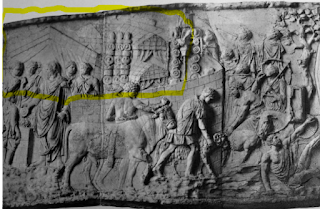This week, I would like to welcome my first guest poster, Ian Borchardt. I have annotated this post with some images for clarity. Also, my thoughts are in italics. I managed to keep my commentary to a minimum, which is also for clarity. This post came about as a MeWe response to last week's Antiquity Tuesday and Ian has graciously allowed me to use his response for the Blog.
Thank you, Ian. And thank you readers.
A legionary conturbium after the Marian reforms consists of eight soldiers, two slaves, and a mule. The items required to set up the camp were shared amongst the conturbium, which was the lowest indivisible group of Roman troops for that reason. Thus they were often assigned duties together. The two slaves and mule stayed at camp, so were often ignored in accounting for the components of a century. Thus you have the strange situation of a "100" only having 80 soldiers. The military slaves/servants (servus) made up the other 20 since they also had to be fed. Camp and the baggage therein was a pretty important part of military life, hopefully, kept separate from battles. Until you lost.
 |
| Tents highlighted in yellow, 1 per conturbium. Image from http://www.trajans-column.org. |
Unlike D&D the legionary didn't fight whilst carrying this load. The two advantages of the furca, or carrying pole, was that you could wear armour whilst using it to carry goods and that it could easily be dropped if you were ambushed en route so that you were unencumbered in a fight. And you could carry the three pilums along with it fairly easily.
 |
| Ian's Icon |
The furca continued to be a very convenient way to carry baggage for a long time (cf my icon, for example). The alternatives tended to be large wicker baskets and porter's trunks, which are not readily shed and more often used for carrying heavy loads. Slinging loads were poles was pretty common.
Wonderful inventions, poles. Although not very useful in a dungeon, but then any sensible legionary would have left the bulk of his gear back in the camp before they went exploring a dungeon.
The loculus, or goatskin satchel, was made from a single goatskin because that was the only way to keep it pretty watertight (as far as the rain was concerned). They were not particularly large as a result. It generally held the few personal possessions of the legionary. This and the other gear of the sarcina were carried in baskets or nets slung from the furca. Including food supplies and tools. All readily discardable in an ambush.
.jpg) |
| Loculus details from Trajan's column. Image from Wikipedia. |
Most legionary food was prepared normally, and locally sourced. Again supplies were delivered to the conturbium as a whole to be prepared for all of its members by its members. This was fairly standard for most armies up to the 18th Century. technically the locals, if neutral or friendly, were given scrip for any supplies that were "requisitioned," but the ability to redeem that scrip depended on the local tracators. Iron rations were never really a thing until the 17th Century when you could determine an army was thinking of going to war because cheese and sausage were suddenly impossible to get for love and money (food that could easily be eaten cold). Most military preserved rations still needed cooking, even if they had a longish shelf-life and could be easily be transported. For example, salted food needs to be soaked to remove a lot of the brine before being prepared.
Next week, I will be trying out a recipe for Roman Hardtack from Pass the Garum, a food history website. As the recipe only has 4 ingredients, hardtack was probably invented and reinvented a zillion times over as a way to preserve the wheat harvest for lean times. (Edit - this has been canceled due to my daughter's Birthday Party. We will properly have cake instead.)
I also base my encumbrance rules on the Roman legionary but tend to consider armour as the primary encumbering item for determining movement rate. The next question is asking what you are doing with your hands, which I often find to be a more useful question to ask when you are carrying stuff than the weight of a thing.
In many regards this is similar to RQ1/2 method of measuring encumbrance in the amount of things. The last question is the weight of what is being carried, which is the strength requirement. Usually such loads are self-encumbering from step two: what is he doing with his hands? Strength really only comes into it when they are trying to lift a specific load.
And I much prefer using Constitution in these matters, not least because it is the characteristic most associated in my game with the Peasant Caste.
Ian has saved me a post on Old School Essentials encumbrance rules. OSE has an item based encumbrance system which trades mass and weight for an item/bundle system which is intuitive and easy to use.










